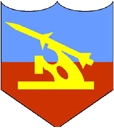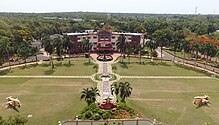 | |
| Former name |
|
|---|---|
| Type | Military |
| Established | 1989; 36 years ago (1989) |
| Affiliation | Corps of Army Air Defence |
| Commandant | Lt. Gen. U. V. Talur, AVSM VSM |
| Location | Gopalpur Cantonment, Ganjam, Odisha, India 19°15′38″N 84°52′08″E / 19.260529°N 84.8689369°E / 19.260529; 84.8689369 |
| Campus | 2728.568 acres (approx) |
| Inaugurated by | Indira Gandhi |
| Colors | Sky Blue & Red |
| Website | AADC-Indian Army |
The Army Air Defence College, (abbreviated as AADC), is the training college for the Army Air Defence Corps of Indian Army. The college is located in the Gopalpur Military Station in Ganjam, Odisha. It spreads over an area of 2728 acres of land. The primary objective of the academy is to impart technical and operational knowledge to the personnel of Indian Army posted to the Corps of Army Air Defence (AAD) about the air defence systems and anti-aircraft warfare. Besides the army personnel, the college also trains personnel from navy, air force and officers from friendly foreign nations..
The history of the college dates back to mid 1940s when anti-aircraft training battery was established by the British in July 1940 at Karachi (now Pakistan) to train the troops deputed to the newly established air defence artillery. Post-independence Air Defence & Guided Missile School and Centre was established at Gopalpur. The school was later renamed as 'Army Air Defence College (AADC)' in 1998. The college enjoyed autonomy after the splitting of the Corps of Army Air Defence from the Regiment of Artillery. In 2008, the Army Air Defence Centre and in 2014 ,Army Air Defence Records were also moved to Gopalpur .

The Army Air Defence College located at Gopalpur is a premier training institute of Indian Army. Army Air Defence College is devoted to training of all ranks in Leadership ,Tactics & Weapons related to Air Defence in Indian Army .
History
Pre-independence
In July 1940, government established training schools for anti-aircraft and coastal defence wings at Karachi. These schools predominantly trained the Indian personnel including commissioned, junior commissioned and non-commissioned officers in anti-aircraft warfare. Unlike the Coastal Artillery School (CAS), which was moved to Deolali, the anti-aircraft training school continued at Karachi till 1947.
Post-independence
Following the independence in August 1947, the training school was moved and merged into the air defence wing of School of Artillery in Deolali. Initially ten courses were proposed for training at different stages in anti-aircraft warfare.
In 1955, Due to lack of facilities and firing ranges available for firing of missiles and other air defence weapon systems, it was proposed to relocate the wing. After the approval of setting up the academy in the 3000 acres of land given by the Government of Orissa in 1968, the government authorized the establishment of Air Defence & Guided Missile School and Centre in 1979. On 1 November 1989, the Air Defence & Guided Missile School and Centre was formally inaugurated as a part of Gopalpur military cantonment.
After the bifurcation of 'Corps of Air Defence Artillery' (later Corps of Army Air Defence) from the Regiment of Artillery in 1994, the college was awarded autonomous status from 10 January 1994.
The 'Air Defence & Guided Missile School and Centre' was rechristened as 'Army Air Defence College' (AADC) in 1998. Later in 2008, the Army Air Defence Centre was also relocated to Army Air Defence College.
Training Infrastructure
The college is equipped with latest state of the art training facilities to train air defence warrior like several types of simulators, class room variants (CRVs), working models of weapon, cut sections and actual parts of radars, guns, missile and air defence systems used by the corps. These include ZSU-23-4B "Shilka", Tunguska Gun Missile System, L/70 Gun Systems, Zu 23 mm gun systems, 9K33 OSA-AK and its variants and the ingeniously developed Akash and MRSAM surface-to-air missile. Besides these, the college holds a computer and electronic lab, combat simulator room, sand model room, EW labs, Akashteer command and control complexes etc. the college is also Centre of expertise (CoE) on C-UAS and EW non Comn aspect. Indoor training comlex is known as Takhshila and outdoor training area is Ashtrshala.
College is having lush green campus with excellent administrative and sports facilities to rejuvenates troops and families staying inside campus. administrative facilities like Nalanda Library, an auditorium ( known as 'AIMA Auditorium'), Sibia sports complex, Army Environmental Park and Golf Course, Samudrika sea beach, Sagarika shopping complex, station sainik institute, officer mess ,Dolphin officer institute , Unit Run Canteen and a lake for different aqua and sailing activities and adventure sports.
Gopalpur Seaward Firing Ranges
The college hosts a seaward firing range, known as Gopalpur seaward firing ranges with a range about 75 km, to conduct the air defence weapon firing and outdoor exercises. This range is also equipped with electro-optical tracking and assessment system for firing analysis and validation of all army air defence systems. The ingenuously developed pilot-less target aircraft: DRDO Lakshya, MEAT and Banshee is used as the target drone.
Commandants
The Commandant of Army Air Defence College is the head of the college. The inaugural holder is Brig AS Sibia. Initially the position was held by a two-star general and later it was elevated to the rank of three-star general. The present commandant is Lt Gen U V Talur, AVSM VSM.
| S.No | Rank | Name | Appointment date | Left office | Later served as the DG of Corps of Army Air Defence |
|---|---|---|---|---|---|
| 1 | Brig | AS Sibia | 15 July 1989 | 22 Mar 1990 | No |
| 2 | Maj Gen | Ram Pratap | 23 Mar 1990 | 31 October 1991 | No |
| 3 | Maj Gen | Y R Jetley, VSM | 15 october 1991 | 31 October 1993 | No |
| 4 | Maj Gen | Jagjeet Singh | 1 November 1993 | 21 December 1995 | No |
| 5 | Maj Gen | S P Malhotra, VSM | 22 December 1995 | 30 September 1997 | No |
| 6 | Maj Gen | Naresh Chand | 1 October 1997 | 31 January 2001 | Yes |
| 7 | Maj Gen | P K Saighal | 2 February 2001 | 28 February 2002 | No |
| 8 | Maj Gen | J S Mahil, AVSM | 19 April 2002 | 7 June 2003 | No |
| 9 | Maj Gen | R K Sudan, AVSM | 23 June 2003 | 31 January 2006 | No |
| 10 | Maj Gen | Ram Pratap, VSM | 2 February 2006 | 4 July 2008 | Yes |
| 11 | Maj Gen | V K Saxena, VSM | 5 July 2008 | 18 September 2009 | No |
| 12 | Lt Gen | Kuldip Singh, AVSM | 1 December 2008 | 30 June 2011 | Yes |
| 13 | Lt Gen | Dr V K Saxena, PVSM, AVSM, VSM | 1 July 2011 | 30 June 2013 | Yes |
| 14 | Lt Gen | Rajiv Bhatia, AVSM | 1 July 2013 | 31 May 2015 | Yes |
| 15 | Lt Gen | A K Sahgal, VSM, ADC | 1 June 2015 | 31 December 2016 | Yes |
| 16 | Lt Gen | P S Jaggi | 30 January 2017 | 15 December 2017 | Yes |
| 17 | Lt Gen | A P Singh, PhD | 16 December 2017 | 23 January 2019 | Yes |
| 18 | Lt Gen | Satinder Singh, AVSM | 24 January 2019 | 31 July 2022 | No |
| 19 | Lt Gen | U V Talur, AVSM,VSM | 1 August 2022 | Till Date | No |
Awards (Since Raising)
1. AVSM-06, 2. VSM-03, 3. COAS COMMENDATION CARD-32, 4 GOC-in-C COMMENDATION CARD-324.
References
- "Commandant". Indian Army AAD. GOI. Retrieved 23 October 2015.
- "19°15'37.9"N 84°52'08.2"E". Google Maps. Retrieved 23 October 2015.
- ^ "History AAD Centre". Indian Army. Retrieved 23 October 2015.
- ^ "Army Air Defence College". Indian Army. Government of India. Retrieved 23 October 2015.
- "AADC". IA. GOI. Retrieved 23 October 2015.
- "22nd RAISING DAY AT GOPALPUR MILITARY STATION". www.orissabarta.com. Retrieved 9 June 2016.
- ^ Kulwant Rai Gupta; Amita Gupta (2006). Concise encyclopaedia of India. New Delhi: Atlantic Publishers & Distributors. ISBN 9788126906376.
- ^ Gautam Sharma (2000). Indian army, a reference manual. New Delhi: Reliance Pub. House. ISBN 9788175101142.
- ^ India: A Reference Annual. Publications Division, Ministry of Information and Broadcasting. 2005. ISBN 9788123012308.
- ^ India. Ministry of Information and Broadcasting; Research and Reference Division (2004). India, 2004: a reference annual. India. Ministry of Information and Broadcasting. ISBN 9788123011561.
- ^ "Infrastructure". Indian Army. GOI. Retrieved 23 October 2015.
- "Army Air Defence". indianprideholders.blogspot.in. Retrieved 9 June 2016.